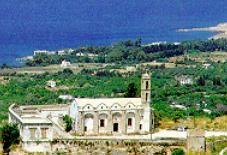
Lapta
(Lapithos)
 The
sprawling, diffuse hill village, 10 km west of Kyrenia,
is spread out over half a dozen levels. A number of springs from the mountain
flow noisily out along irrigation channels to water the surrounding gardens and
groves of citrus and olive. There are half a dozen attractive whitewashed
churched scattered throughout the village, though none of them dates from before
the 18th century.
The
sprawling, diffuse hill village, 10 km west of Kyrenia,
is spread out over half a dozen levels. A number of springs from the mountain
flow noisily out along irrigation channels to water the surrounding gardens and
groves of citrus and olive. There are half a dozen attractive whitewashed
churched scattered throughout the village, though none of them dates from before
the 18th century.
The village itself is much
older, founded by refugees from Lambousa
seeking safety in the high ground from pirate raids. Lapithos was the seat of an
Orthodox bishopric, until it was suppressed by the Catholic Crusader state in
the 13th century.
Lapta also contains one of the
island's most handsome stone mosques, whose classical Ottoman silhouette of
minaret, square prayer hall, hexagonal drum and dome can be seen in Dumlupinar
street. The cliff face by the town hall is enlivened by a waterfall fed by a
spring at the head of the valley. A short but still arduous walk begins along a
back road, at town hall level, and passes below the old Ayios Varvara church on
its way to the smaller village of Karshiyaka, 4 km to the west. A dirt track to
the left of Karshiyaka café twists uphill to give an approach for the climb of
the summit of Kornos, a distinctive 946m high summit, on the western edge of the
Gothic (Kyrenia) Range.
References
• Rogerson, B., (1994), Cyprus,
Cadogan.


 The
sprawling, diffuse hill village, 10 km west of
The
sprawling, diffuse hill village, 10 km west of